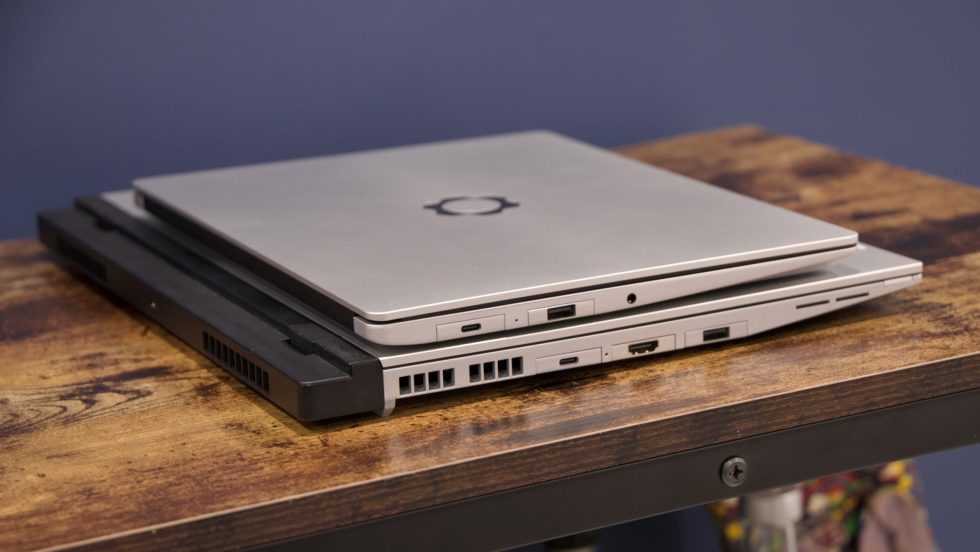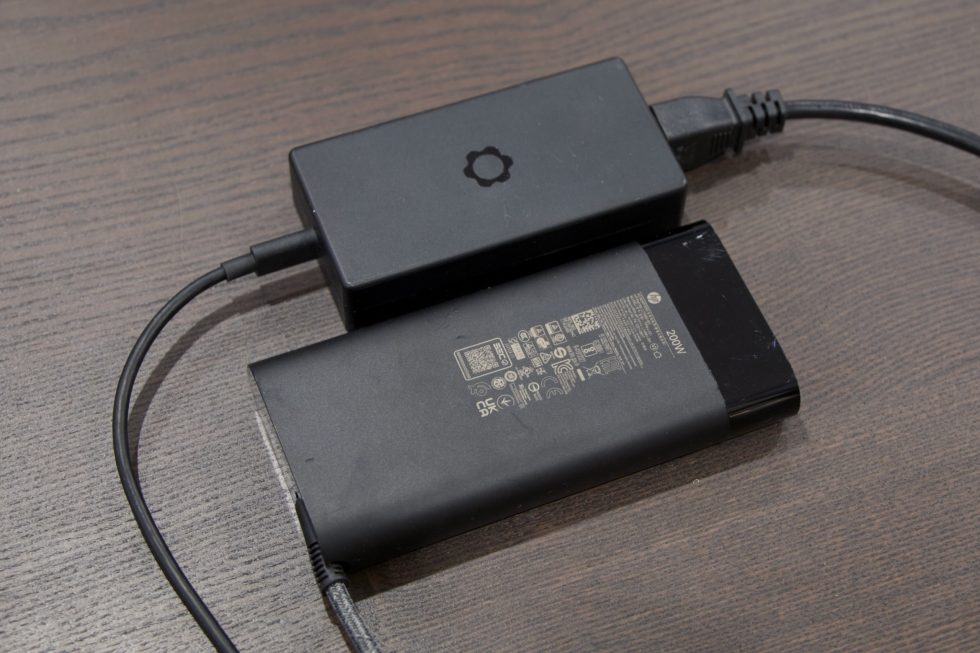

Review: Framework’s Laptop 16 is unique, laudable, fascinating, and flawed
source link: https://arstechnica.com/gadgets/2024/01/review-frameworks-laptop-16-is-unique-laudable-fascinating-and-flawed/
Go to the source link to view the article. You can view the picture content, updated content and better typesetting reading experience. If the link is broken, please click the button below to view the snapshot at that time.

Design touches and new upgrades
The new Framework Laptop is a whole lot bigger than the old one—without its dedicated GPU installed, it's nearly two pounds heavier, 3 inches wider, and 1.5 inches deeper. Adding the graphics module adds another two-thirds of a pound and almost an inch of extra depth.
The whole point of it is that it's bigger than the original—the star of the show is a lovely matte non-touch panel with a 2560×1600 resolution, a 16:10 aspect ratio, and roughly 97 percent DCI-P3 gamut coverage. But it's striking just how much bigger the laptop is, while devices like the Dell XPS 15 or Apple's 16-inch MacBook Pro have at least tried to retain some of the slimness of those companies' smaller notebooks.
While the Laptop 16's height, width, and weight aren't totally out of the ordinary for a laptop this size—all three numbers are on the high side, but even with the GPU installed they aren't breaking any records—but the laptop with its dedicated GPU module installed is around two inches deeper than most of the laptops we spot-checked it against. That increases its footprint by a lot, and may keep it from fitting in some bags comfortably.
| Framework 16 (no GPU) | Framework 16 (GPU) | Apple 16-inch MBP | Dell XPS 15 9530 | Lenovo ThinkPad P1 Gen 6 | HP ZBook Studio G10 | Lenovo Legion Pro 5 Gen 8 | Razer Blade 16 | |
|---|---|---|---|---|---|---|---|---|
| Size (H x W x D inches) | 0.71 x 14.04 x 10.63 | 0.82 x 14.04 x 11.43 | 0.66 x 14.01 x 9.77 | 0.71 x 13.57 x 9.06 | 0.68 x 14.1 x 9.6 | 0.72 x 14.02 x 9.54 | 0.86-1.05 x 14.3 x 10.25 | 0.87 x 13.98 x 9.61 |
| Weight | 4.63 lbs | 5.29 lbs | 4.7-4.8 lbs | 4.21-4.23 pounds | 3.92 lbs | 3.81 lbs | 5.51 lbs | 5.4 lbs |
The design of the Framework Laptop 16 is a unique mix of clunky and clever. It retains some of the external design compromises from the Laptop 13 (a fairly boxy design, thick bezels) and adds a few of its own. The expansion module that contains the GPU juts out from the back of the laptop past the lid, something I associate more with monstrous, unpleasant 17-inch gaming laptops, and the seams all over the keyboard and wrist rest area make it look sort of unfinished.
Advertisement
But this external awkwardness is mostly done in service of an internal elegance, and there are a ton of handy design touches made to boost the laptop's modularity and upgradeability.
-
The Framework Laptop 16's customizable keyboard area is one of the cooler things about it. Here's a centered keyboard with individually programmable RGB backlighting, flanked by a pair of neat-but-superfluous "LED Matrix" spacers.
-
The first step toward taking the Laptop 16 apart is pulling out these small tabs on each side, which allow you to slide out these spacers.
-
Removing the trackpad is the next step. Observe the metal contacts on both the laptop and the trackpad module.
-
I usually use the Laptop 16 with its keyboard centered, but a couple different numpad modules (including this "RGB macropad") exist.
The most impressive is the keyboard and trackpad area, which is one big replaceable slab on Framework 13, but on Framework 16, it is fully customizable. This is enabled by a clever system of magnets and copper contact pads that allow the keyboard, trackpad, and other components to connect to the motherboard via the USB bus without involving the bendy, fiddly ribbon cables that usually connect laptop keyboards and trackpads. Everything in the keyboard and wrist rest area can be fully disassembled and reassembled without tools, just like the expansion bays for ports (up to six, from the Framework Laptop 13's four, but without a built-in headphone jack).
Of all of the new stuff in the Framework Laptop 16, this is also the part that most obviously one-ups the experience of opening up the original Framework Laptop. All of these components can be shifted around without exposing the laptop's sensitive internal components or even turning the computer off, making it dead easy to remix and experiment. Capable web-based interfaces for programming the keyboard's RGB backlight, customizing macros, and adjusting other settings are also available. We'd like to see some more offline fallbacks available for this so you're not completely screwed if the website ever goes away—offline beta apps are available for the cosmetic "LED Matrix" add-ons, so hopefully it's coming for the keyboard eventually, too.
Advertisement
-
Sliding out the "expansion bay shell," which is mostly empty except for a pair of cooling fans.
-
Once the keyboard is up, you'll see this little access panel that tells you to turn the power off before proceeding.
-
Under that door you'll see the area where the expansion module connects to the rest of the system (in this picture, the connecting piece has already been taken out; these are just the contacts).
-
The module is connected to an eight-lane PCIe interface and power with this small interposer.
-
The GPU module (top) is considerably faster than the integrated GPU, but it also takes up a lot of space and weighs more.
The other big coup for expandability and upgradeability is the removable GPU. The Framework Laptop 16 uses a sort of compression-attached physical interposer (it's two surfaces filled with copper contacts for data and power, pressed up against each other with screws) to provide an eight-lane PCI Express interface for extra accessories. This could eventually lead to the creation of expansion modules that do pretty much anything—Framework says one with extra M.2 slots for more SSDs is on its way, and everything about the interface Framework is using is publicly available on GitHub—but dedicated graphics modules are probably the most obvious kind of accessory (more on this Framework Laptop's specific graphics module in a bit).
Framework has written a bit about developing both of these internal connectors, including the work it did to make the interposer from the graphics module something that could stand up to repeated removal and reinstallation. I've detached the graphics module from my review unit twice without issue—as long as you're careful about making sure things line up properly and not forcing anything, you should be fine.
The other nice thing about the Laptop 16 design is its charger, which at 180 W could be gigantic but is actually relatively svelte thanks to newfangled gallium nitride (GaN) technology. Even a couple of years ago, this wouldn't have been possible, both because GaN was relatively new and because USB-C's peak power limit didn't exceed 100 W until relatively recently. It's much more pleasant to transport and use than any gaming laptop power brick I've come into contact with.
Recommend
About Joyk
Aggregate valuable and interesting links.
Joyk means Joy of geeK

